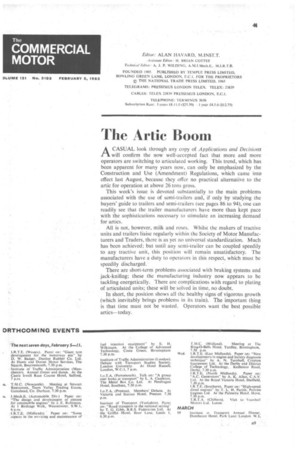The Artie Boom
Page 43

If you've noticed an error in this article please click here to report it so we can fix it.
A CASUAL look through any copy of Applications and Decisions will confirm the now well-accepted fact that more and more operators are switching to articulated working. This trend, which has been apparent for many years now, can only be emphasized by the Construction and Use (Amendment) Regulations, which came into effect last August, because they offer no practical alternative to the artic for operation at above 26 tons gross.
This week's issue is devoted substantially to the main problems associated with the use of semi-trailers and, if only by studying the buyer's' guide to trailers and semi-trailers (see pages 86 to 94), one can readily see that the trailer manufacturers have more than kept pace with the sophistications necessary to stimulate an increasing demand for antics.
All is not, however, milk and roses. Whilst the makers of tractive units and traffersliaise regularly within the Society of Motor Manufacturers and Traders, there is as yet no universal standardization. Much has been achieved; but until any semi-trailer can be coupled speedily to any tractive unit, this position will remain unsatisfactory. The manufacturers have a duty to operators in this respect, which must be speedily discharged.
There are short-term problems associated with braking systems and jack-knifing; these the manufacturing industry now appears to be tackling energetically. There are complications with regard to plating of articulated units; these will be solved in time, no doubt.
In short, the position shows all the healthy signs of vigorous growth (which inevitably brings problems in its train). The important thing is that time must not be wasted. Operators want the best possible artics—today.


















































































































































































